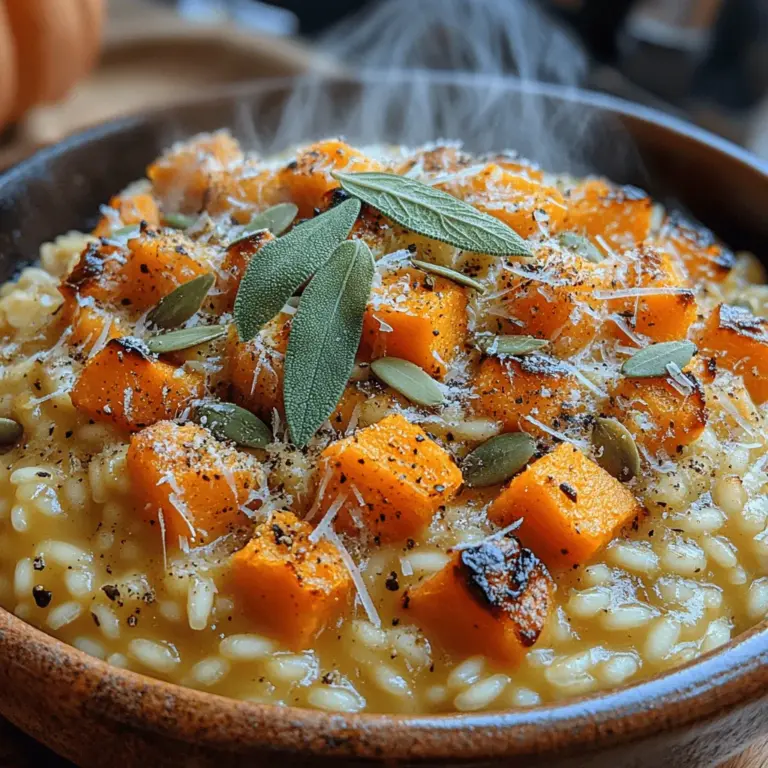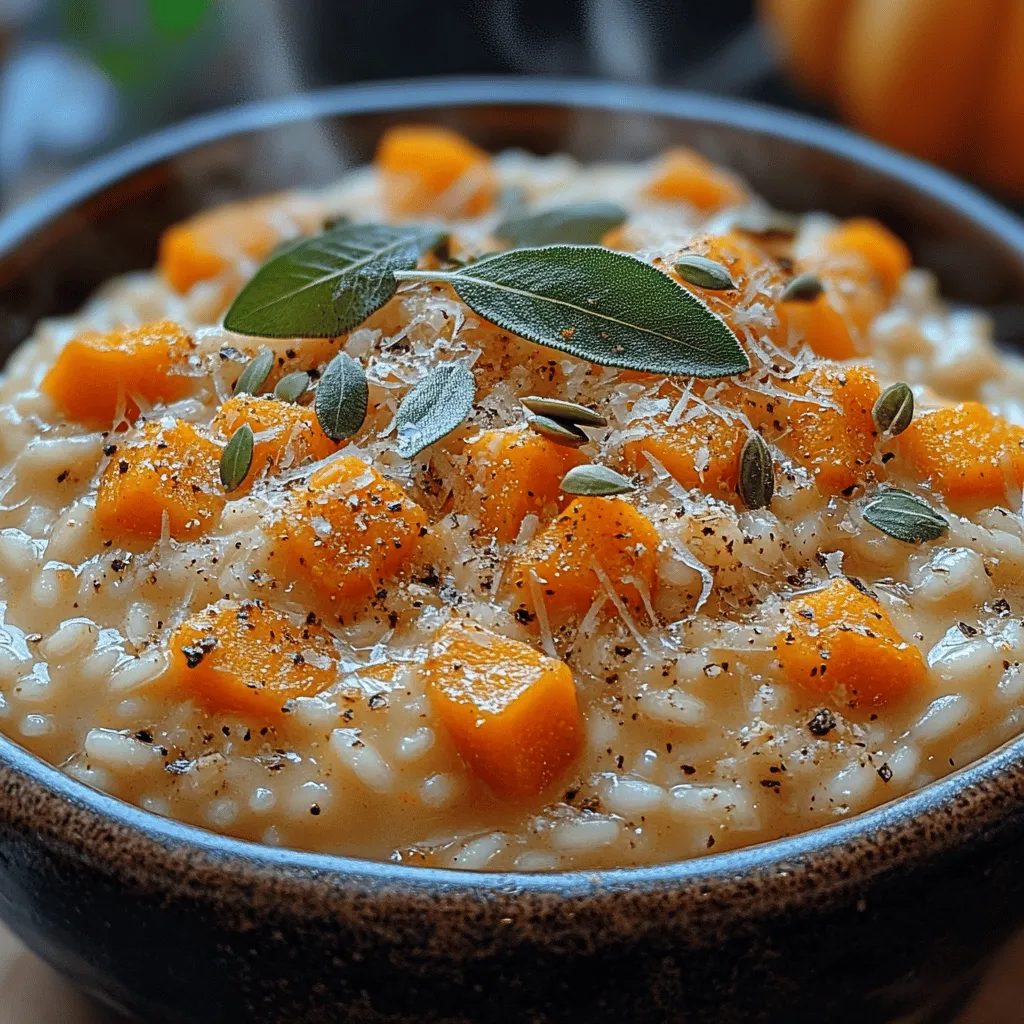Introduction
As the leaves begin to change and the air turns crisp, there’s nothing quite as comforting as a bowl of creamy risotto. Among the many variations, Velvet Butternut Squash Risotto stands out not only for its vibrant color but also for its rich, velvety texture and the warmth it brings to chilly evenings. This dish celebrates the sweetness of butternut squash, complemented by the earthiness of Arborio rice, creating a perfect harmony of flavors that encapsulates the essence of autumn.
The appeal of this recipe lies in its simplicity and versatility. It’s a dish that can be enjoyed on special occasions or as a warming weeknight meal. With the right approach, it allows even novice cooks to impress family and friends with a gourmet experience at home. The combination of seasonal ingredients not only enhances the flavor profile but also offers a myriad of nutritional benefits, making this risotto a wholesome choice.
Butternut squash is a star during the fall harvest, and using fresh, seasonal produce is crucial in crafting a dish that sings with flavor. This recipe invites you to explore the bounty of autumn, emphasizing the importance of cooking with ingredients at their peak ripeness. Each spoonful of this risotto tells a story—not just of the flavors but also of the traditions and memories tied to family meals and shared moments around the table.
Understanding the Ingredients
Fresh Produce: The Star of the Dish
At the heart of Velvet Butternut Squash Risotto is, of course, butternut squash. This beautiful winter squash is known for its sweet, nutty flavor and creamy texture when cooked. When selecting butternut squash, look for one that feels heavy for its size, with a firm, smooth skin and a rich, tan color. The flesh should be deep orange, indicating a high level of beta-carotene, which is beneficial for eye health and a powerful antioxidant.
The process of preparing butternut squash involves peeling, seeding, and dicing it into uniform cubes to ensure even cooking. Roasting the squash brings out its natural sweetness, contributing to the depth of flavor in the risotto. This method caramelizes the sugars in the squash, creating a beautiful contrast to the creamy rice.
Nutritional Benefits and Flavors
Butternut squash is not only delicious but also packed with nutrients. It is an excellent source of vitamins A and C, fiber, and potassium. This vegetable’s natural sweetness pairs wonderfully with savory components, making it a perfect match for risotto. The addition of seasonal herbs like sage or thyme can enhance its flavor profile, adding a fragrant freshness that complements the richness of the dish.
Proteins: Choosing the Right Source
While risotto is traditionally a vegetarian dish, the addition of protein can elevate it further and make it a complete meal. Depending on your dietary preferences, you have several options:
– Meats: For a heartier version, consider adding sautéed chicken or pancetta. Chicken breast offers lean protein without overpowering the dish, while pancetta adds a salty, savory depth that beautifully contrasts the sweetness of the squash.
– Legumes: For a vegetarian option, chickpeas or lentils can provide a protein boost. Chickpeas add a nice texture and nutty flavor, while lentils offer a creamy consistency that melds well with the risotto.
– Plant-Based Proteins: If you’re looking for a vegan option, consider incorporating tofu or tempeh. Tofu absorbs flavors well, while tempeh adds a slightly nutty taste and chewy texture.
Each protein choice impacts the overall flavor and texture of the risotto, allowing for customization based on dietary needs and preferences.
Aromatics and Spices: Building Flavor
No risotto is complete without the right aromatics and spices to build a foundation of flavor. The essential aromatics for this Velvet Butternut Squash Risotto include onions and garlic.
– Onions: Sweet onions are preferable for their mild flavor that caramelizes beautifully when sautéed, adding a sweet base to the dish.
– Garlic: Adding minced garlic elevates the flavor profile, infusing the risotto with its aromatic essence.
Herbs like fresh sage or thyme not only add depth but also bring a seasonal note that enhances the dish’s overall character. The warmth of sage, in particular, pairs wonderfully with the sweetness of the butternut squash, creating a perfect balance.
To further round out the flavors, a pinch of nutmeg can be added. This spice, often associated with comfort foods, complements the richness of the squash and the creaminess of the risotto.
Preparation Techniques
Prepping Your Ingredients
Preparation is key to achieving the perfect risotto. Start by washing your butternut squash thoroughly, ensuring that any dirt or contaminants are removed. Next, peel the squash using a vegetable peeler, and cut it in half to remove the seeds. Dice the squash into even cubes to ensure they cook uniformly.
If you’re incorporating proteins, this is also the time to marinate them if necessary. For example, if you’re using chicken, consider marinating it in olive oil, salt, and a touch of lemon juice to enhance its flavor and tenderness.
Cooking Methods Explained
The cooking methods used in this recipe—roasting, sautéing, and simmering—are integral to developing the dish’s flavor profile.
– Roasting: Begin by roasting the diced butternut squash in the oven. Toss the cubes in olive oil, salt, and pepper, then spread them on a baking sheet. Roasting at a high temperature caramelizes the squash, intensifying its sweetness and creating a lovely texture.
– Sautéing: In a large pot or Dutch oven, heat olive oil over medium heat. Add the diced onions and sauté until they become translucent, followed by minced garlic. This step infuses the oil with aromatic flavors that will enhance the risotto.
– Simmering: As the rice cooks, it will absorb the flavors of the broth and aromatics. Use a high-quality vegetable or chicken broth to impart a rich taste to the risotto. The key is to stir frequently, allowing the rice to release its starch, creating a creamy consistency.
Timing and Temperature
Managing cooking times for different ingredients is crucial in achieving the desired results. When adding the roasted butternut squash to the risotto, ensure that it is done roasting and has a nice caramelization. The timing of adding broth is also essential; adding it gradually allows the rice to absorb the liquid slowly, resulting in perfectly cooked, creamy risotto.
Temperature control is equally important. Start with medium heat to sauté the aromatics, then lower the heat once the rice is added. This gentle simmer allows the rice to cook evenly without becoming mushy.
Step-by-Step Recipe Instructions
Detailed Breakdown of Each Step
1. Roast the Butternut Squash: Preheat your oven to 400°F (200°C). Prepare the butternut squash as described above, then spread the cubes on a baking sheet. Drizzle with olive oil, season with salt and pepper, and roast for about 25-30 minutes, or until tender and caramelized.
2. Sauté Aromatics: In a large pot, heat 2 tablespoons of olive oil over medium heat. Add the diced onions and sauté until translucent, about 5 minutes. Stir in the minced garlic and cook for an additional minute until fragrant.
3. Add Arborio Rice: Add 1 cup of Arborio rice to the pot, stirring to coat the grains with the oil and aromatics. Toast the rice for about 2-3 minutes until the edges become translucent.
4. Incorporate Broth: Begin adding warm broth (vegetable or chicken) one ladle at a time, stirring frequently. Wait until the liquid is mostly absorbed before adding the next ladle. This process will take about 18-20 minutes, and the rice should be al dente and creamy when done.
5. Combine Ingredients: Once the rice is cooked to perfection, gently fold in the roasted butternut squash, along with any additional herbs or spices you prefer. Stir in grated Parmesan cheese (or a plant-based alternative) for added creaminess.
As we continue to explore the steps involved in creating this Velvet Butternut Squash Risotto, we will delve deeper into tips for ensuring success and how to personalize this dish further to suit your taste preferences. Stay tuned for the next installment, where we’ll cover the essential tips and tricks for achieving the perfect risotto that is not only a feast for the eyes but also a delicious and nourishing meal.


